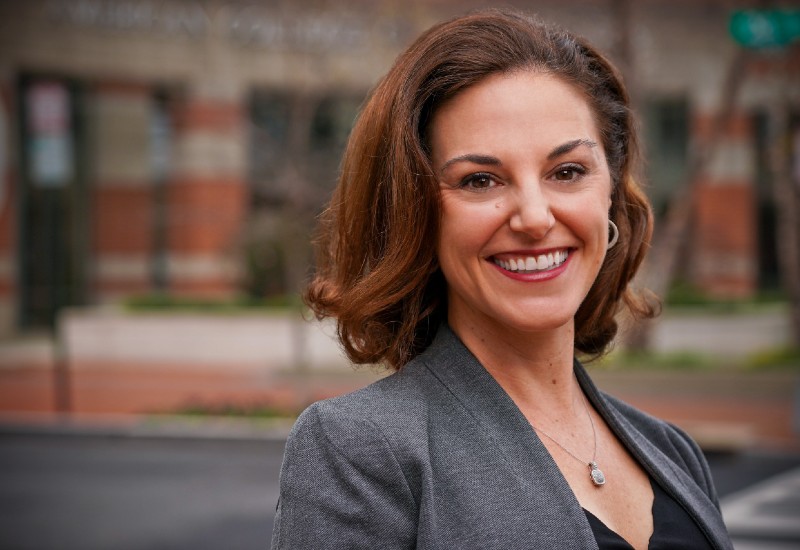Melissa Kearney on Marriage and Children

A common trope in America depicts a traditional family of a married husband and wife and their 2.5 (yes, 2.5) children as the norm, if not perhaps the ideal. Leaving aside the idea of a “traditional” coupling or what the right number of children might be, is there an advantage to growing up with married parents?
Definitely, argues Melissa Kearney, author of The Two-Parent Privilege: How Americans Stopped Getting Married and Started Falling Behind and the Neil Moskowitz Professor of Economics at the University of Maryland. In this Social Science Bites podcast, she reviews the long-term benefits of growing up in a two-parent household and details some of the reasons why such units have declined in the last four decades.
As befits her training, Kearney uses economics to analyze marriage. “Marriage,” she tells host David Edmonds, “is fundamentally an economic contract between two individuals—here, I’m gonna sound very unromantic—but it really is about two people making a long-term commitment to pool resources and consume and produce things together.”
In her own research, Kearney looks specifically at being legally married within the United States over the last 40 years and what that means when children are involved. Her findings both fascinate her and, she admits, worries her.
“We talk at length in this country about inequality as we should, but this divergence in family structure and access to two parents and all the resources that brings to kids and the benefits it gives kids in terms of having a leg up in sort of achieving things throughout their life—getting ahead economically, attaining higher levels of education—[well,] we will not close class gaps without addressing this.”
She provides data showing that the percentage of young Americans living with married parents is indeed falling. In 2020, 63 percent of U.S. children lived with married parents, compared to 77 percent 40 years earlier. Meanwhile, 40 percent of children are born to unmarried parents.
While these percentages are evenly distributed across the geography of the U.S., they are less so among the nation’s demographics. For example, children born to white or Asian, more educated or richer mothers are more likely to be born within wedlock.
“The mechanical drivers of this,” Kearney explains, “are a reduction in marriage and a reduction in the share of births being born inside of marital union, not a rise in divorce, not a rise in birth rates to young or teen moms.” But economics does seem to be a driver, Kearney said – especially among men.
As cultural tumult saw marriage itself growing less popular starting in the 1960s, non-college-educated men saw their economic prospects dimming. “We saw a reduction in male earnings or a reduction in male employment and a corresponding reduction in marriage and rise in the share of kids born outside of marital union. So, there is a causal effect here, economic shocks that have widened inequality hurt the economic security of non-college educated men, and this rising college gap and family structure.”
Over time, new social norms were established, so even when the economic prospects of non-college-educated men rise, there is not a corresponding increase in marriage and decrease in non-marital births. “Once a social norm has been established, where this insistence on sort of having and raising kids in a marital union is broken, then we get this response to economic shocks that we might not have gotten if the social norm towards two-parent households and married-parent households was tighter.”
In addition to her work at the University of Maryland, Kearney maintains a large footprint in the policy world. She is director of the Aspen Economic Strategy Group; a research associate at the National Bureau of Economic Research; a non-resident senior fellow at Brookings; a scholar affiliate and member of the board of the Notre Dame Wilson-Sheehan Lab for Economic Opportunities; and a scholar affiliate of the MIT Abdul Jameel Poverty Action Lab, known as J-PAL.
So it’s no surprise that she closes her interview with some policy suggestions.
“[I]mproving the economic position of non-college-educated men, I think, is necessary but won’t be sufficient. We need more wage subsidies. We need a lot of investment in community colleges throughout the country—they train workers throughout the country—we need to be shoring up those institutions. We need to be stopping bottlenecks in the workforce that make it harder for people without a four-year college degree, or for people who have criminal past, right, criminal history—all of those things. We need to be removing barriers to employment, investing in training, investing in skills, investing in paths to families to sustaining employment.”
To download an MP3 of this podcast, right-click HERE and save. The transcript of the conversation appears below.
For a complete listing of past Social Science Bites podcasts, click HERE. You can follow Bites on Twitter @socialscibites and David Edmonds @DavidEdmonds100.
TRANSCRIPT
David Edmonds: Fewer kids in the United States are being brought up in households with married parents. Does that matter? Melissa Kearney argues that it matters a lot. She’s an economist at the University of Maryland and author of The Two-Parent Privilege. Melissa Kearney, welcome to Social Science Bites.
Melissa Kearney: Thank you so much for having me.
Edmonds: The topic we’re talking about today is marriage. So, within the social sciences, you might think that marriage would be of interest to sociologists. It’s a much more unusual subject for an economist. Why would an economist care?
Kearney: Marriage is fundamentally an economic contract between two individuals—here, I’m gonna sound very unromantic—but it really is about two people making a long-term commitment to pool resources and consume and produce things together. That’s how we model marriage. But once you recognize how important economics is to marriage, and marriage is to economics, it’s impossible not to see the married unit as a really important economic unit in society,
Edmonds: We should be clear that what you study is the legal recognition of a marriage union, between a man and a woman. We’re not talking about civil partnerships, which are now available for same sex couples, and at least in the UK, also for opposite sex couples.
Kearney: So, that’s an important question. In my work, what I really do is look at first how marriage impacts or predicts whether a household is headed by two adults, and then look at the impact that that has on kids outcomes and household outcomes. And so, in my data work, and very clear as to whether what I see in a particular data set, is whether somebody is legally married, or whether they’re living with an another adult partner. in the US marriage, and two parent households are very, very, very tightly correlated. So, we don’t have in the US sort of these very long-term stable commitments outside marriage the way some European countries do.
Edmonds: Let’s have some facts and figures. Your focus is primarily on the United States. And it’s common knowledge that marriage has been in decline, actually, across the developed world. But give us some hard stats. There are two important components, I guess, to this: first, whether people are getting married in the first place, and second, whether they’re staying married. So, what’s the data on that?
Kearney: The trends that I’m particularly interested in and frankly, worried about, is the decline in marriage among parents. So, if I look at kids in the US, what’s happened to their living arrangements over the past 40 years: in 2020, only 63 percent of U.S. kids lived with married parents. That’s a huge drop from just 40 years ago. In 1980, it was 77 percent. And this timing is important because this timing is posed the social cultural changes of the 60s and 70s. So, the real big decline in marriage from the perspective of kids, right, the decline in marriage among their parents has happened post 1980. So, 63 percent of kids are living with married parents.
If instead we just think about how many kids are living with two parents, just add a couple more percentage points to it. Because like I said, in the US, that’s not really that large of a share. Importantly, marriage is what’s driving this change, because what’s happened in the US is really—and this is, by the way, happening in the UK, and increasingly in other European countries as well—there’s been a decoupling, a debundling of marriage from having and raising kids. You refer to staying married; this is not being driven by divorce. In fact, now in the US, if we look at non partnered mothers, so mothers who have no other not a spouse, or an unmarried partner, whether another man or woman, they consider a partner in their house, the small majority of them have gotten there by never being married. So, marriages are actually more stable than they used to be, because fewer people are getting married, the bar to getting married is higher. But what’s happened is really this decline in marriage among adults overall, and then also among adults who have children together.
Edmonds: So just to be clear, the big increase in the number of kids who are now in households with just one parent is a result of their mother, and I guess more rarely their father never getting married in the first place.
Kearney: Exactly. Forty percent of kids in the US now are born to unmarried parents. And again, this is consequential to how they wind up being raised in their living family, because not many of those parents will actually then live together in a long-term situation.
Edmonds: Can we unpick those figures a bit further? Are there interesting notable race or class or regional differences to unpack?
Kearney: One hundred percent. So, I’m really focused on the fact that what’s happened over the past 40 years is the emergence of a very wide socio-economic class gap in this. Kids born to the highest educated parents are still overwhelmingly being raised in two-parent, married-parent homes at similar rates in the past, but kids born to less-educated parents, and now, not just the least educated, but the middle group, the majority of kids’ moms do not have a four-year college degree. And what’s happened over the past 40 years is that the share of them living with married parents has converged down—single parenthood used to really just be concentrated among the least economically advantaged the lowest education groups. That’s not happening anymore.
So let me put numbers on this. So, now in the US, 84 percent of kids whose moms have a four-year college degree live with married parents, as compared to less than 60 percent of kids whose parents don’t have a college degree. That’s a 24-percentage point gap. That’s huge. And that has emerged entirely over the past 40 years.
You also asked about race differences. In the US, starting in the 60s and 70s, we saw an emergence of a black/white gap in two-parent families. Those level differences have persisted and taken on this class gap dimension as well. Among kids of white moms, among kids of black moms, among kids of Hispanic moms—what’s happened over the past 40 years is this huge class gap. So again, let’s put some numbers on this. Among white children in the US, or children of white moms, 80 percent of those whose moms have a four-year college degree live in a married parent home, as compared to 69 or 60 percent of moms with only a high school degree or less. There’s also a huge class gap, education class gap, among kids of black moms. Sixty percent of those whose moms have a four-year college degree live with married parents, as compared to only 30 percent of black children whose moms don’t have a four-year college degree. An interesting exception is the racial ethnic group of Asian Americans. So there, we see uniformly high rates of two parent households throughout the education distribution. There’s really not this drop off outside the college educated class.
Edmonds: So elsewhere, though, a huge correlation between the gap and class and race. And I asked about regional differences as well. I was wondering whether this might be a north/south thing or an urban/rural phenomenon.
Kearney: I wondered about that, too. And really, interestingly, the data showed that this widening class gap, this reduction in kids being raised in two-parent homes, married parent homes outside the college educated class has happened in almost equal proportion throughout the regions of the US. It’s also happened in nearly equal proportion in urban and rural areas.
Edmonds: There’s obviously multiple explanations for this trend, but is it possible to identify one or two major causes?
Kearney: Sure. So, let’s just reiterate: the mechanical drivers of this are a reduction in marriage and a reduction in the share of births being born inside of marital union, not a rise in divorce, not a rise in birth rates to young or teen moms. OK, so why is that? Well, my read of the data, and the evidence is that there’s been an interaction of economic shocks that have hit primarily outside the college-educated class and a change in social norms that has really led to this decoupling of marriage and raising kids. So like we said, already, there were these major social-cultural changes in the 60s and 70s, the share of adults getting married sort of fell in rough proportion among all education groups, and then what happened in the 80s and 90s—a whole bunch of economic changes that really sort of eroded the economic position, both in a level sense and a relative sense compared to women, of non-college-educated men. So we saw a loss in manufacturing jobs, we saw a loss in middle skilled well-paying jobs for certain segments of the population: non college educated men living in particular places that were hit by things like import competition, the adoption of industrial robots, these sort of economic changes. And in those places, in those population groups that were more impacted, we saw a reduction in male earnings or a reduction in male employment and a corresponding reduction in marriage and rise in the share of kids born outside of marital union. So, there is a causal effect here, economic shocks that have widened inequality hurt the economic security of non-college educated men, and this rising college gap and family structure. Again, college educated adults have done quite well, and they’ve continued to get married.
Edmonds: So I still don’t quite understand the cause of it. So, you have men who’ve been hit economically, particularly working-class men. And that means what? That they’re just less attractive as a catch for women? How does that work?
Kearney: So, who’s making this decision, whether it’s men or women, I can’t tease out in this sort of aggregate course data and methods I use as an economist. My sense of this—I’ll use economic terms for a second here—we get into this equilibrium, where there’s less marriage among these populations. And whether it’s being driven by women deciding, “You know what, these men, they’re not stable financial contributors, they’re in and out of work. We know when people are in and out of work, particularly men, there’s other struggles, right? So they’re not going to be a good partner, to me, meanwhile, this is a good thing, I can make it on my own a bit, I’m still economically insecure. But I’d rather try to do this by myself, then have that guy in and out of our house in and out of work,” or whether it’s men saying, “I don’t want this responsibility, I’m not sure I’m going to have a family supporting wage for the next 30 years, I don’t want to be tied down to have to pay for a wife and kids,” whichever side is driving it, it’s probably some of both, we see this happening.
But I want to emphasize two things about the role of social norms here. Once a social norm has been established, where this insistence on sort of having and raising kids in a marital union is broken, then we get this response to economic shocks that we might not have gotten if the social norm towards two-parent households and married-parent households was tighter. And I actually have some work, like, looking at this. I was looking for a reverse marriageable men story. So let me quickly describe this study I did with my colleague, Riley Wilson. The fracking boom in the US in the 2000s was actually a really good economic shock for non-college educated men, it increased employment opportunities in various sectors where these communities had fracking. What I expected to see, what I hypothesized, was, “Oh, now college educated men, their economic stability opportunities has increased, we’ll see an increase in marriage and a reduction in the non marital birthshare.” The data don’t show that at all. What happens in those communities is people did have more kids. And there’s lots of work showing that actually, when people get more income, one of the things they do is use the money to have more kids, we see an increase in kids. But it’s an equal proportion to unmarried and married parents. We don’t see an increase in marriage. When you look at a very similar economic shock in the 70s and 80s, you see an increase in marriage, a reduction in the non marital birthshare. So this sort of supports this idea that how people respond to economics depends on the social context are living in.
Edmonds: The norm with no marriage has now been established as it were. And it’s almost impossible to reverse.
Kearney: I hesitate to say impossible, because I think that this really has been a damaging trend for children, in particular, for parents who are struggling to do all this on their own, for society more broadly, because this has widened inequality and undermines social mobility. So, I’d hate to give up on it. But I think it will be very hard to reverse because you have this baked in now.
Edmonds: OK, so you’ve touched on the implications there. Let’s talk a bit about why this matters. We’ve got this big increase in kids being brought up with parents who are unmarried, mostly living in single parent households. Why does this matter?
Kearney: Let’s first start at a sort of a micro level of household level. It is undeniable that households with one parent have fewer resources than households with two parents. And of course, right, the astute social scientist is going to say, well, one parent households are much more common among lower income groups. But even conditional on that, let’s take moms with just a high school degree, those who are raising kids by themselves and those who are raising kids with a married or unmarried partner in the household have different levels of resources. Why? Because a household with two adults is much more likely to have two adults bringing income into the household. So at a very basic level, this is a really important mechanism that can’t be dismissed. Households with two adults have higher levels of income. So even conditional on mother’s education level, age or race or where she lives, households with two adults are less likely to live in poverty, the kids are more likely to have access to more resources.
Income is a big part of the story, but it’s not the only mechanism. If you look at time use, we see that married parents both separately and collectively have more time to spend on their kids. Again, this isn’t rocket science. If there’s another adult in the household, right, either you go to work, or you mow the lawn, or you cook dinner while I read to the kid—it’s not surprising that kids and married parent households get more time with their parents. And the third thing that researchers have shown, both economist, development psychologists, sociologists, is that there’s less stress, there’s more emotional bandwidth in married parent households, for parents to parent the way development psychologists say is helpful for kids. And all of this we see translates into better outcomes for kids. So again, conditional and baseline differences between moms, we see that kids who have the benefit, or what I call on my title, the privilege of growing up in a two-parent, married-parent households, they’re less likely to live in poverty, they’re more likely to graduate high school, they’re more likely to go to college and graduate; their outcomes are better.
Edmonds: I assume that most of the kids living with just single parents are living with their moms. And I assume also, but correct me if I’m wrong, that it must make a vast difference. Whether the dad is, as it were, not under the same roof, but on the scene, helping out with resources, we’ve taken the kids to soccer club or whatever. Is that the case?
Kearney: Yes. So here’s again why it matters that more kids have sort of found themselves or moms have found themselves in this position by never being married, then being divorced, because children whose parents are divorced are more likely to have child support from the, you know, the second parent, typically, the dad coming into the household, they’re more likely to see and engage with their dad. And so even the sort of status of how parents got to this position of being unmarried really matters for the resources that kids have exposure to. Again, just looking aggregately, descriptively in the data, kids whose parents have been divorced and remarried, kids outcomes are sort of in between those growing up with single parents and those growing up with stably married parents. And this sort of supports your intuition: those kids have some type of resource access that’s in the middle of what you’d have if you had stably married parents versus just a single mom and no sort of engagement from the second parent.
Edmonds: Good. And as a matter of interest, is single parenthood worse for girls or boys? Or does it make no difference?
Kearney: This is a good question. And a lot of really compelling recent research has shown that actually growing up without a dad in the household is particularly problematic for boys. So let me describe one important study on this that worked really hard to get at causal effects and mechanisms. It’s a study by The Economist, Marianne Bertrand and Jessica Pong. They have access to tons of nationally representative data on kids, and they look at the gender gap and outcomes. So, actually, boys are doing observably worse than girls on a lot of dimensions, now. They’re more likely to get in trouble in school, they’re more likely to get in trouble with the criminal justice system, they’re less likely to go to college. And what these authors sort of unpack is how much of that can be explained by what we know has happened over this time, which is that kids are less likely to grow up with a dad in their house. And what they show very convincingly is that the gender gap in kids’ outcomes, so the relative disadvantage of boys compared to girls, compared to their sisters, is larger in households headed by single moms. Like, let me be very clear, this is not to denigrate single moms at all. Raising kids is hard, and raising kids by yourself is even harder. And so what they show is that in these households, boys do have relatively less nurturing from their mother, they have less time with their mother as compared to their peers in married parent homes. But what’s really interesting in their research is they show that boys are particularly responsive to these inputs. And so when boys get less parenting attention, they are more likely to get themselves in trouble than girls.
Edmonds: Right. One interesting fact I learned from your research is that this inequality rather depressingly cascades through multiple generations in various ways. So, for example, if you’re raised in a single parent household, you yourself are much more likely to end up as a single parent.
Kearney: This is why I think it is really critical that we address this issue, this widening family gap in the US, the rising incidence of kids being raised without two parents in their home outside the college educated class, because this is a huge impediment to upward mobility, social mobility. We talk at length in this country about inequality as we should, but this divergence in family structure and access to two parents and all the resources that brings to kids and the benefits it gives kids in terms of having a leg up in sort of achieving things throughout their life—getting ahead economically, attaining higher levels of education—we will not close class gaps. without addressing this,
Edmonds: Can we turn to the policy implications? It would seem that the most obvious policy implication is that we should try and reverse the trend in the rise in single parent families. But you were just telling me early on in this conversation that that’s almost impossible to do. So, where we left, what are the implications of this?
Kearney: Yeah, so really, what I’m hoping to accomplish with this work is getting us to recognize that strengthening families and addressing the rise in single parent families has to be considered a policy priority. And it’s not, and a lot of people don’t want to talk about it, or a lot of people want to say, sure that’s happening, but it’s all about income, we just have to get more income to single mother households, right? So we have to recognize this as a policy priority. And then we also have to recognize this is really not going to be solved by just making our welfare system more generous to single parents.
And to be clear, I absolutely think we should have a stronger safety net. In particular, in the in the US. I absolutely think we need to have a stronger safety net, even if it leads—somewhat paradoxically to everything else I’ve been saying—even if that leads to an incremental increase in the share of single parent homes. I just refuse to accept that we let so many millions of kids in this country sort of languish inmaterial deprivation that hinders their human capital, their health and education, development and wellbeing. But we also have to meet families where they are. So, it’s really not helpful to say, just get married, more people need to get married, right? That’s just not helpful. Because we have to understand why are so many couples who have children together, not getting married, what are the barriers to them establishing healthy long term committed relationships. And here’s where an emphasis on programming aimed at building up families, not just trying to make up for the deficits of family life by more school counselors in school, more childcare subsidies—I’m all for those things, but we actually have to help families achieve stable, healthy, long term, two-parent situations for kids. And that means experimenting, and testing and investing in programming that does that.
The larger challenge is to try and reverse the decline in marriage in the sense of again, not just wagging our fingers telling people to get married, but figuring out why has the value proposition of marriage outside the college educated class declined. And that speaks to like, we need to do all the things to improve the economic stability, security of non college educated men in particular.
Edmonds: OK, but be specific, is there one or two policy proposals that you might have—you’ve said it would be very difficult to reverse the trend—but something that might stop the trend and possibly help reverse it?
Kearney: Sure. So, let’s start with, again, recognizing that improving the economic position of non college educated men, I think, is necessary but won’t be sufficient. We need more wage subsidies. We need a lot of investment in community colleges throughout the country—they train workers throughout the country—we need to be shoring up those institutions. We need to be stopping bottlenecks in the workforce that make it harder for people without a four-year college degree, or for people who have criminal past, right, criminal history—all of those things. We need to be removing barriers to employment, investing in training, investing in skills, investing in paths to families to sustaining employment.
Now, let me go to something that, you know, is more directly investing in families. Our Department of Health and Human Services has an Administration for Children and Families. 1% of their budget is spent on programs that are dedicated towards family strengthening as compared to 15% on foster care. You know, we’re committed to getting kids out of negligent or abusive family situations. But then in this country, we do very little to then help the family itself improve. We spent $85 million on strengthening families, that number needs to have a B instead of an M, right? We need to be really, really investing in these programs that are targeted at strengthening families.
Edmonds: Now, when I asked some social scientists, whether they have a normative agenda, some will say yes, some will say no. It seems to me that your findings are likely to be given a warmer reception by Republicans than by Democrats. It fits with a conservative view about the importance of the family. In that sense, this research feels intrinsically normative. Is that fair?
Kearney: It’s really interesting because when I talk to people in the social science field they know and they’ll say, “Are you sure you want to be out there saying this? You sound socially conservative,” which is not the in group among academic social scientists. When I tell people about my ideas that are not in this world at all, they’re like, “Oh, OK, so we just need to convince Republicans to spend more money on families.” And like, funny you should say that. Because there’s actually this like cultural war in the social scientists that I think surprises some people out because it feels like. “Wait, who would deny that two-parent homes are beneficial for kids? And who would say we shouldn’t spend more money on families,” right? So, there is something here for both social conservatives and progressives to like and not like. My research and my impetus for writing this book was not normative, it was positive in the sense of, I’m looking at the data, I’m looking at the evidence, it is overwhelming. If we really are serious about inequality in this country and improving kids’ wellbeing, we have got to support the family and recognize that the decline in the two-parent family has been bad for kids. There’s where I draw my normative conclusion. My normative conclusion: is we cannot give up on the two-parent family for kids, we have to reinforce that norm, and that norm and that goal should guide our policy and programming. And then here’s where I’m going to lean more into progressive instincts of, “We need to be spending more money helping low-income families.”
Edmonds: Melissa Kearney, thank you very much indeed.
Kearney: Thanks for having me.
–






























































































